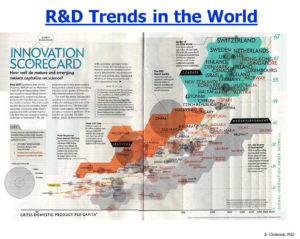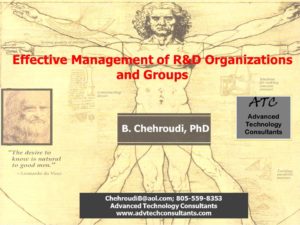Effective Management of R&D Teams and Organizations 
In today's technology-driven global economy, innovation is at the core of the survival-of-the-fittest organization. The innovation process begins with the identification of market needs or technology opportunity and then goes through stages, such as adopting or adapting existing technology that satisfies the identified need or opportunity, inventing when needed, and finally transferring this technology by commercialization or other instrumental means. Effective and efficient R&D management can have profound and determining consequences, considering the key role it plays in the economic health of a nation and the world as a whole, the profitability of a business enterprise, the effectiveness of a technology-based governmental agency, and the enormous investment nations make in R&D activities. Today, the complexity of the technology creates complex organizations in which many disciplines have to be coordinated. It is the manager's primary responsibility to bring components together so they can operate smoothly and harmoniously, each making an optimal contribution to the R&D organization.
Managing R&D organizations and concentrating on their productivity and excellence offers a unique set of problems and unusual challenges that are amplified when the team is scattered spatially in a global economy. This uniqueness arises primarily from two basic facts: (1) the character of the enterprise, and (2) the highly-specialized, articulate, and autonomous people involved in R&D. As American economist and Nobel laureate Kenneth J. Arrow stated, "The central economic fact about the processes of invention and research is that they are devoted to the production of information." Obviously, the generation of information requires research
and, in addition to the R&D organizations' focus on information, research involves considerable uncertainty because the outcome can never be predicted perfectly from the different inputs used. It will, therefore, become clear in this course that managing an R&D organization is largely the art of integrating the efforts of diverse, creative, intelligent, and independent individuals. The ideas presented in this course consist of the condensed works of a multitude of experts focusing on ways to improve the productivity of R&D and foster excellence and innovation in organizations.
The course is intended for all levels of managers, supervisors, and team/group leaders who wish to improve their leadership, management, motivational, and communication skills for creating optimum individual and team performance in R&D organizations. It is particularly useful to scientists, engineers, project managers, and other technical personnel who intend to make a transition to management positions in an R&D environment or who want to improve their own leadership and/or followership skills. It also is beneficial for faculty members, group leaders, department heads, research administrators, managers responsible for sponsoring research, and policy makers in science and technology.
This seminar is also sponsored by the American Society of Mechanical Engineers (www.asme.org): Click on ASME.
Electronic and hard copies of the seminar materials can be purchased and are only available through ATC. Contact ATC for price and shipping.
NOTE: Professionally-prepared "audio-video Powerpoint-type presentations" of these seminars are available for purchase by companies. Each slide is presented with a clear audio by the consultant, describing the subject, while a digital pointer guides the audience to where the attention is to be focused. Companies can put such audio-video presentations on their intranet to be used by their employees. It is a cost effective way of approaching professional training, which also contributes towards R&D, design, and intelligent new product development efforts. Presentations are updated every year at a fraction of the original cost. For a sample presentation click on the word "R&D" in the picture to get a feel of how information is transferred (High-speed internet access is recommended. Otherwise, download may take a few more minutes). The actual copy sold is of high resolution with high quality sound. For more details and pricing please contact ATC.
How to Arrange for a Presentation:
Individuals who are interested in this seminar should contact Advanced Technology Consultants (ATC) directly. Due to ATC's low overhead, direct-contact clients are offered a competitive and cost-effective package. Alternatively, you can contact American Society of Mechanical Engineers (ASME) website for schedule and registration. This course was initially prepared for the University of California at Los Angeles (UCLA) and subsequently offered by the ASME.
Upon completing this course, participants should:
- Receive a concise, yet effective, overview of the management issues specific to R&D environment
- Know ways to improve R&D organization productivity and foster excellence
- Learn and understand the innovation process in effective R&D organizations and can intelligently use it for their own corporation
- Understand the effective reward system and communication style in order to achieve optimal results from their R&D department
- Be prepared and conditioned to make a smooth and efficient transition from a pure technical staff to a management and leadership position
- Learn the essence and ingredients of a successful technology transfer process in an R&D atmosphere
- Be able to effectively contribute to the management and leadership teams in their corporation
- Develop the background and necessary foundation to educate themselves beyond the depth and topics covered in this course
"One man's research is another man's routine",
Prof. Antoni K. Oppenheim
DAILY SCHEDULE
FIRST DAY:
- R&D Organizations and Research Classification
- What is research and development?
- Basic or applied research
- Unique issues in R&D management
- Components Required for R&D Organizations
- Staff, ideas, communication, funds, culture
 The match of a person and the job
The match of a person and the job
- Creating Effective and Productive R&D Organizations
- Organization effectiveness
- Specific characters of inventors/innovators
- Management, researcher, and peer relationships
- Group/team formation
- Ethos of a scientific community
SECOND DAY:
- Motivation in an R&D Environment
- A human behavior model
- Reward system and its change to sustain and support scientific/technical careers
- Organizational structure for optimum communication
- Leadership and Issues in R&D Organizations
THIRD DAY:
- Technology Transfer Issues
- Technology transfer stages
- Innovation
- Role of people and market
- Organizational issues in technology transfer
- Strategies
- A case study
- Strategic Planning for R&D Organizations
- Strategy in the context of a corporation
- Technology strategy
- Strategic planning
- Strategic thinking and management
- An example of a strategic plan
- New product development
- R&D portfolio management & optimization
- Technology roadmapping, economic forecasting, and investment opportunities
- Disruptive technologies and their evaluations
- Case Studies and Discussion (numerous throughout the seminar) From Harvard Business Review (HBR)
- Summary and Conclusions
Note: for best outcome and maximum absorption, it is recommended that the above topics are covered in 4 days to allow ample time for case studies and group discussions.
Testemonial:
From: Sebastian Timar <sdtimar@gmail.com>
Date: Wednesday, December 27, 2017
Subject: Re: Season’s Greetings
To: chehroudib <chehroudib@aol.com>



